The notes of the Tesorería de la Federación
At the end of 1913 Colonel Wilfrido Massieu Pérez was appointed military chief of the city of Monterrey, Nuevo León. He defended the city with his 2.500 men against Constitutionalist General Pablo González’s force of 15.000 men, but on 25 April was obliged to withdraw to Saltillo, Coahuila, where he remained military chief until 11 June 1915.
On 27 January 1914 the Treasury of the Federation at Saltillo decreed an issue of paper money in denominations of 10, 25, 50 centavos and 1, 2 and 5 pesos.
These had the printed signatures of Wilfrido Massieu Pérez as Jefe de las Armas, Praxedis de la Peña y Flores as Governor and as Eugenio Soberón as Jefe de Hacienda.
|
On 13 June 1913 he was sent as Jefe de Estado Mayor for Brigadier Joaquín Maas’s column which was countering Carranza’s uprising in Coahuila and took part in the whole campaign, particularly the capture of Monclova on 10 July, for which he was promoted to Coronel. At the end of 1913 he was appointed by Maas to be Jefe de las Armas in Monterrey, and on 28 February 1914 he was made a General Brigadier. From 19 to 25 April, with 2,500 men, he held the city against Pablo González and his 15,000 Constitucionalists. He managed to evacuate the city, saving most of his forces, and retired to Saltillo, where Maas named him Jefe de las Armas, a post he held until 11 June 1915. He retired to Mexico City in June 1915 and lived there for five years. In 1920 he was appointed Director of the Escuela Industrial Militar in San Luis Potosí but only served for a short time and afterwards was director of the city’s trams. In 1921 the Minister for Education, José Vasconcelos, appointed him Director of the Escuela de Ferrocarrileros, later transformed into the Instituto Técnico Industrial, a post he held until his death on 26 March 1944. |
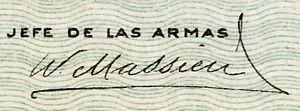 |
|
Pra He was a cousin of Ernesto Madero and uncle of Francis I. Madero, and the Madero family favoured him over Venustiano Carranza for the governorship of Coahuila. He was provisional governor from August to November 1884 and from August to December 1909 and interim governor from 21 November 1913 until 2 February 1914. |
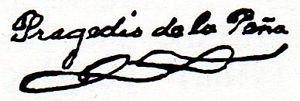 |
|
[If right person] José Eugenio Soberón Valdés was born in Matehuala, San Luis Potosí, in 1869, a relative of Matías Hernández Soberón who married Eugenio’s half-sister. In June 1910 he was elected to the board of the Mexican Stock Exchange (Bolsa Mercantil de México)El Tiempo, Año XXVII, Núm. 8,886, 17 June 1910 and elected again in October 1916El Pueblo, 10 October 1916. |
 |
The Mexican Herald reported that there were to be $100,000 in such valesThe Mexican Herald, 19th Year, No. 6,720, 25 January 1914. A report to the American State Department from the National Paper and Type Company, dated 17 February, said that this was an issue of a million pesos but that only part had so far been put into circulationSD papers, 812.515/13.
10 centavos
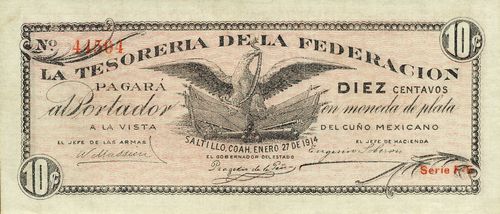
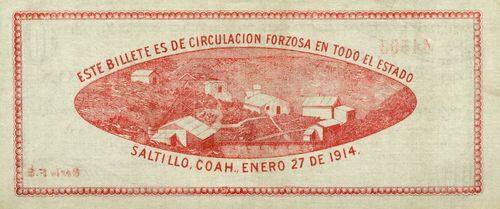 M1085 10c Tesorería de la Federación
M1085 10c Tesorería de la Federación
| Series | from | to | Total Number |
Total Value |
|
| F | includes numbers 22721CNBanxico #76 to 44504 | ||||
| F-A | includes numbers 3192CNBanxico #78 to 14373 | ||||
| F-B | includes number 0923 | ||||
| F-C | includes number 33432 | ||||
| F-D | |||||
| F-E | |||||
| F-F | |||||
| F-G | |||||
| F-H | |||||
| F-I | includes numbers 4360CNBanxico #10204 to 5511 |
25 Centavos
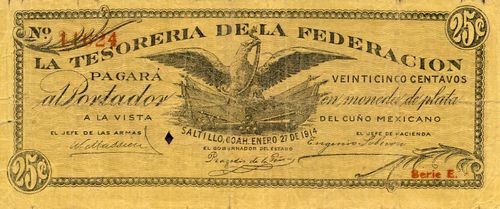
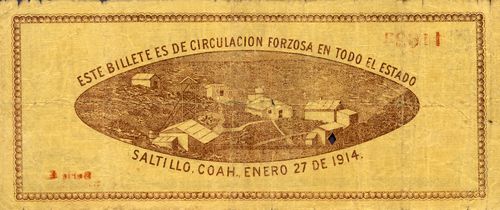 M1086 25c Tesorería de la Federación
M1086 25c Tesorería de la Federación
| Series | from | to | Total Number |
Total Value |
|
| E | 1 | 100000 | 100000 | 25,000 | includes number 11624 to 98267CNBanxico #80 |
50 Centavos
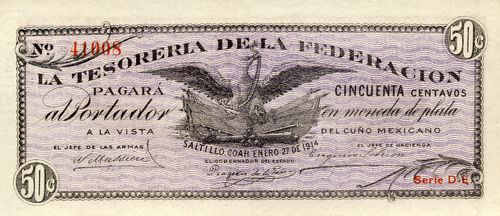
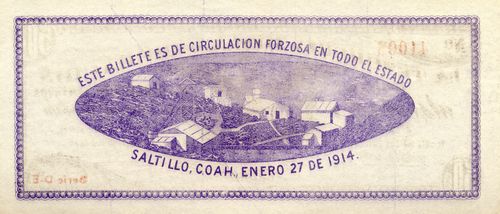 M1087 50c Tesorería de la Federación
M1087 50c Tesorería de la Federación
| Series | from | to | Total Number |
Total Value |
|
| D | includes numbers 28707CNBanxico #89 to 44276CNBanxico #85 | ||||
| D-A | |||||
| D-B | includes numbers 11699CNBanxico #84 to 43446 | ||||
| D-C | includes numbers 4349 to 46592CNBanxico #87 | ||||
| D-D | includes numbers 17781 to 28237 | ||||
| D-E | includes numbers 5845 to 41008 | ||||
| D-F | includes numbers 8512CNBanxico #83 to 49200 | ||||
| D-G | includes numbers 20992CNBanxico #82 to 22630CNBanxico #86 | ||||
| D-H | includes numbers 19762CNBanxico #10206 to 47348CNBanxico #81 |
$1
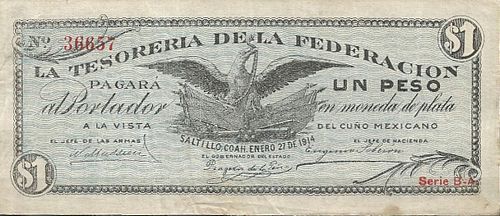
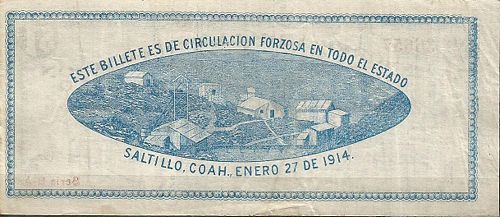 M1088 $1 Tesorería de la Federación
M1088 $1 Tesorería de la Federación
| Series | from | to | Total Number |
Total Value |
|
| B | includes numbers 0388CNBanxico #93 to 42043CNBanxico #10208 | ||||
| B-A | includes numbers 0165 to 44845CNBanxico #99 | ||||
| B-B | includes numbers 6853CNBanxico #10207 to 13195 | ||||
| B-C | includes numbers 9497 to 40740 | ||||
| B-D | includes numbers 12468 to 25592 | ||||
| B-E | includes numbers 5152CNBanxico #95 to 49526CNBanxico #100 |
$2
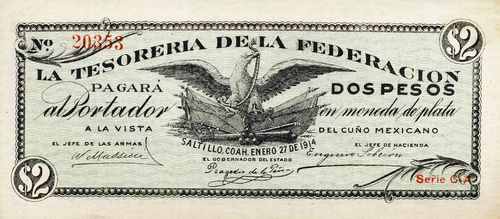
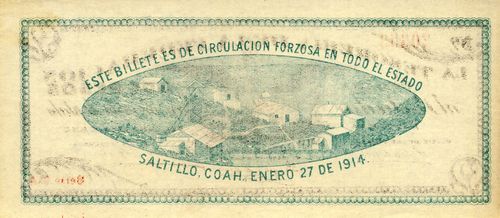 M1089 $2 Tesorería de la Federación
M1089 $2 Tesorería de la Federación
| Series | from | to | Total Number |
Total Value |
|
| C | includes numbers 2788CNBanxico #116 to 45680CNBanxico #107 | ||||
| C-A | includes numbers 3440CNBanxico #10209 to 36400CNBanxico #108 |
$5
| Series | from | to | Total Number |
Total Value |
|
| A | includes numbers 3580CNBanxico #110 to 38292 |
Revalidations
Notes are known with a circular or oval stamp of the Jefatura de Hacienda, Coahuila.
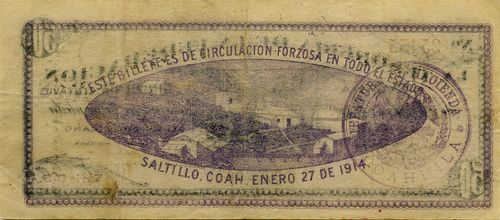
circular seal
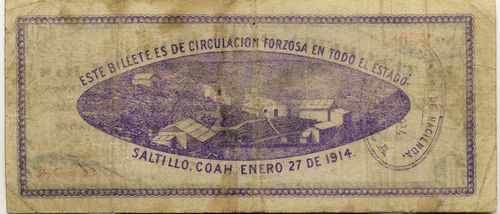
oval seal
Withdrawal
By March it was announced by the Secretaría de Gobernación that the notes were to be redeemed. All federals offices in the state were instructed to take up such of the vales as were presented for collection, with the federal government sending the necessary funds. The Minister, Ignacio Alcocer, wrote that “in order to appease merchants, the President (Huerta) has authorized me to announce that they may deposit in any public office the amount of government vouchers in their possession so that a like amount of cash may be immediately made available to them”The Mexican Herald, 19th Year, No. 6,780, 6 March 1914.
On 6 May the Carrancista Pablo González nullified the Huertista issues of Coahuila, Nuevo León and Tamaulipas[text needed].
However, in the areas still under federal control they continued to circulate. When General Joaquín Maass was forced to quit Saltillo, he withdrew to San Luis Potosí where he continued to pay his troops with these notes, saying they would later be exchanged for banknotes or coinsEl País, Tomo I, Año XVI, Núm. 4,649, 14 August 1914.
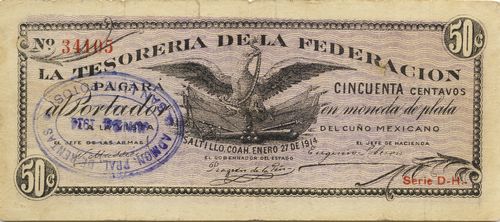
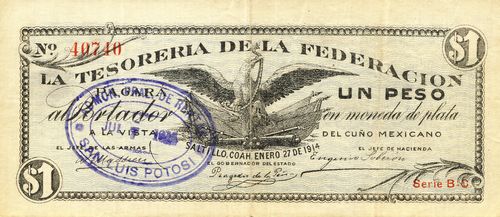
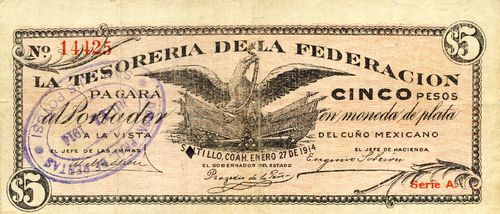
In San Luis Potosí, the Prefecto Regional General Almazán declared them of forced circulation on 1 June and three days later threatened business who refused to accept them. Antonio Kalixto Espinosa Antonio Kalixto Espinosa, Papel moneda de la Revolución Mexicana, que circulo en San Luis Potosi, 1981 records the oval stamp ‘ADMON PRAL DE RENTAS - SAN LUIS POTOSI’ with dates from 24 June to 10 July and also a large round violet seal with ‘PREFECTURA REGIONAL DEL PARTIDO DE SANTA MARIA DEL RIO, S. L. P.’However, on 19 July, once he had taken the town, Pablo González reiterated his order that the Huertista issues of Saltillo and Monterrey were worthless.
By 24 July almost all businesses in Querétaro had closed rather than accept these notes from soldiers and the governor was worried about potential lootingAMQ, actas de Cabildo, exp. 73, 24 de julio de 1914, fs. 137 Acta of extraordinary session 24 July 1914. The town council agreed that businesses would open and accept the vales provisionalesAMQ, actas de Cabildo, exp. 73, 27 de julio de 1914, fs. 137-137v Acta of extraordinary session 27 July 1914. Meanwhile, many female camp-followers possessed this money and at the Secretaría de Guerra in Mexico City, General Velasco announced that the notes would be exchanged by the paymasters (pagadores) in the Divisions for legal tender, taking steps to avoid any exploitation by speculatorsEl País, Tomo I, Año XIV, Núm. 4,631, 27 July 1914; El Imparcial, Tomo XXXVI, Núm. 1920, 27 July 1914.
By August many of the notes had fallen into the hands of speculators, acquired at low prices. So the Secretaría de Guerra announced that they would only redeem notes for people who could prove that they had received them for expenses. Since the Tesorería understood that many army paymasters had also hoarded large quantities of these notes it ordered an investigation to find the guiltyEl País, Tomo I, Año XVI, Núm. 4,649, 14 August 1914.
On 29 August Carranza’s Subsecretario de Hacienda, Felicitos Villarreal, in discussing Huertista issues, stated that only the Obligaciones Provisionales were valid, not those issued by ex-general Joaquín Maass which had circulated in Coahuila and Nuevo LeónEl Dictamen, Año XVI, Núm. 1259, 29 August 1914.
In early September 1914 a San Antonio, Texas newpaper reported that in Mexico City an order prohibiting the circulation of banknotes and vales del Tesoro issued during Huerta’s regime[text needed] caused riots. Though the government used troops, the disturbances did not stop until the Carranza cabinet instructed the banks to honour the Huertista moneyPrensa, San Antonio, 3 September 1914.
On 26 September Federico Montes, governor of Querétaro, agreed to redeem $5,000 which the Administración General de Rentas held in Huertista notes (vales del Saltillo y otros)AQ, Fondo Poder Ejecutivo Sec 2ª 26 October 1914, Exp. 70. However, on 28 September the Secretaría de Hacienda In Mexico City refused the exchange as the notes were no longer legal tenderibid..
On 27 September the presidente munipal of San Juan del Río, asked for instructions on billetes y vales de Jefes Militares, since for the present all types were circulating, so as not to damage the interests of the holders. He was informed of Carranza’s decree núm. 21, told that there was no definite ruling on notes of Constitutionalist Jefes Militares but that those issued by Jefes of the former government should not circulateAQ, Fondo Poder Ejecutivo Sec 2ª Hacienda C-2 Año 1914 Exp. 19.
The worthlessness of these notes was subsequently confirmed by the Secretaría de Hacienda on 15 OctoberThe Mexican Herald, 20th Year, No. 6,978,15 October 1914 and by Carranza in his decree of 8 December 1914.

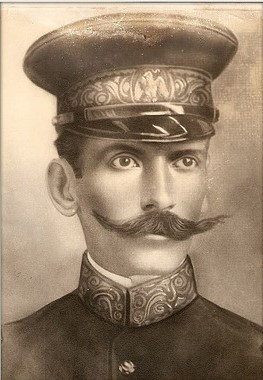 Wilfrido Massieu Pérez was born in Tacubaya, D.F., on 27 December 1878. He entered the Military College on 22 December 1896 and graduated as a Teniente de Ingenieros on 6 December 1903. He stayed in the Corps of Engineers (Cuerpo de Ingenieros), where he was in charge of various construction projects, until 1914.
Wilfrido Massieu Pérez was born in Tacubaya, D.F., on 27 December 1878. He entered the Military College on 22 December 1896 and graduated as a Teniente de Ingenieros on 6 December 1903. He stayed in the Corps of Engineers (Cuerpo de Ingenieros), where he was in charge of various construction projects, until 1914.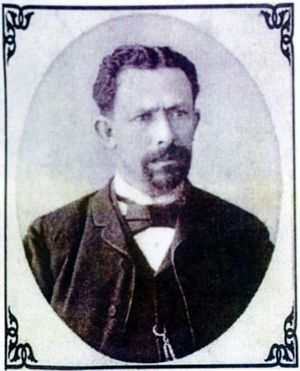 gedis de la Peña y Flores was born in Saltillo on 18 November 1847. He was a practising lawyer and businessman. Amongst his many business interests, besides being Director General of the
gedis de la Peña y Flores was born in Saltillo on 18 November 1847. He was a practising lawyer and businessman. Amongst his many business interests, besides being Director General of the